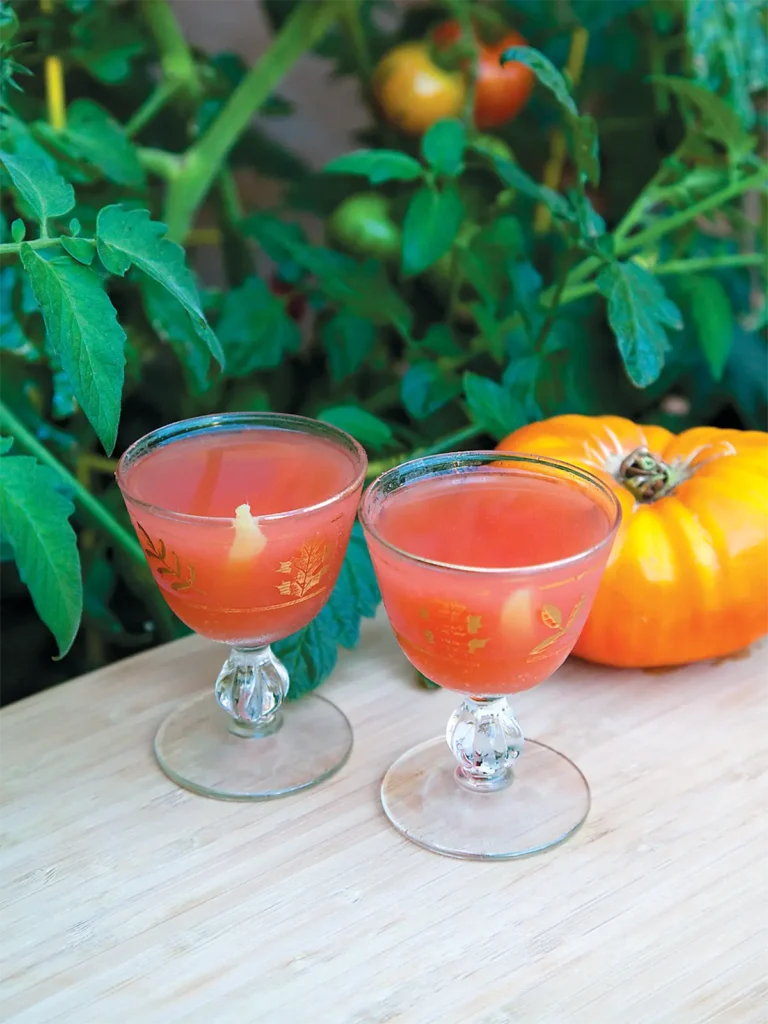The Wolf Peach
You Say Tomato, I Say Wolf Peach

One of the things you learn if you live in Santa Barbara is that fall is really summer. It seems the mercury climbs the highest in September and October. Meanwhile our gardens are just peaking, while people we know around the country have often pulled everything out or gone to crop cover. We are rich in tomatoes and basil, and our citrus tend to thrive.
This article will take that late-summer-into-fall bounty and turn it into a refreshing cocktail anchored by a local distilled spirit.
The base of this cocktail is American Star Vodka from Ascendant Spirits in Buellton, the first distillery to open in Santa Barbara County since Prohibition. If you’re going to be using local tomatoes, and one might hope homegrown tomatoes, it can’t hurt to work with a local vodka. Especially since American Star is delightful, distilled five times, 100% from corn, very clean with just a smidgen of sweetness, not as much sugary as fruity.
That helps stress how a tomato is a fruit, too, and in this drink you juice it more than you pulverize it. Despite the ingredients, this isn’t merely an anemic Bloody Mary.
Part of the reason for that is the other liquor component, Lillet, is a vermouth on subtle steroids, with its quinine, citrus liqueurs and spices. Far from local, Lillet hails from Bordeaux, France, where it’s often drunk as an aperitif. Adding it to this cocktail not only provides more of the lovely rose color, but it also rounds out the flavors and gives depth to a drink that is a bit astringent, in that classic chasing-the-martini way.
The species name for tomatoes is lycopersicum, which loosely translates to “wolf peach” in Latin. It refers to German werewolf tales in which nightshade fruit could turn one into a werewolf, or so it was believed. So the tomato (as part of the nightshade family) got transformed into the “wolf peach” (how a peach is hairy and a tomato isn’t and how that gets you to a werewolf is still a little unclear).
But it’s easy late in the summer to have too many tomatoes. A cocktail is the perfect place to use, and abuse with your muddler, one that’s a bit past its prime in firmness or looks. Indeed, heirloom tomatoes, so often imperfect, practically cry out to be made into this drink.
Similarly, late gardens often end up with basil going to flower. Since you strain all the solids away, even flowers work in the shaker since they are highly aromatic. If you’ve got it, lemon basil adds one more flavor note that sings along with the preserved lemons, and you have to use preserved lemons. They heighten and brighten the lemon flavors, and the salty touch takes the cocktail into a wonderful dimension that few cocktails short of margaritas can do.
You can make your own preserved lemons relatively easily if you’ve got enough lemons (preferably Meyer lemons) and a pint jar. Wash them, quarter them almost to their bottom—keep them connected like a flower opening its petals. Hang on to the juice as you do this process. Salt the lemons with kosher salt. Put salt at the bottom of the jar, and then squeeze in the lemons so they become pasty with juice and salt. Add more salt along the way, so you end up using about a ¼ cup when you’re done (you really can’t oversalt these). Be sure there’s lemon juice all the way to the top of your lemons. Leave a bit of air space, seal and wait for 30 days—that’s the hardest part.
Beyond this cocktail, use the preserved lemons in salad dressing, for fish dishes, anywhere salt and citrus are a good addition. You will never have enough preserved lemon again, so the good news is that you can buy it. Hilltop and Canyon Farms make wonderful ones available at the Santa Barbara Farmers Market. To use, pull out the lemon you need, strip off to the pith, and use only the skin, which you need to rinse, too, unless you are addicted to salt.







